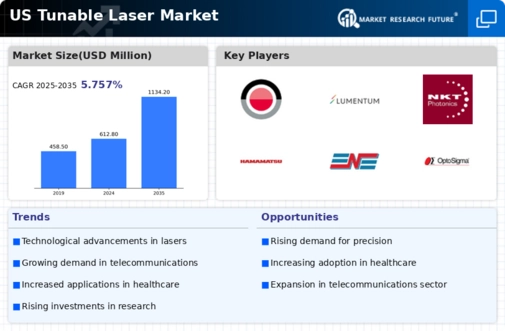Advancements in Laser Technology
Technological advancements in laser technology are significantly influencing the tunable laser market. Innovations such as improved wavelength tuning mechanisms and enhanced output power are making tunable lasers more efficient and versatile. These advancements are likely to broaden the scope of applications, particularly in scientific research and medical diagnostics. The tunable laser market is expected to benefit from these developments, with market analysts predicting a growth rate of around 10% annually over the next five years. As researchers and practitioners seek more sophisticated tools for experimentation and analysis, the demand for advanced tunable lasers is anticipated to rise, further propelling the market forward.
Growing Demand in Industrial Applications
The tunable laser market is witnessing a notable increase in demand from industrial applications, particularly in manufacturing and quality control processes. Tunable lasers are utilized for precise measurements and material characterization, which are essential for ensuring product quality and compliance with industry standards. The market is projected to grow as manufacturers increasingly adopt laser-based technologies for non-destructive testing and process monitoring. Reports indicate that the industrial segment could account for over 30% of the total market share by 2026. This trend suggests that the tunable laser market is becoming integral to enhancing operational efficiency and product reliability in various manufacturing sectors.
Rising Applications in Telecommunications
The tunable laser market is experiencing a surge in demand due to its increasing applications in telecommunications. As the need for high-speed data transmission escalates, tunable lasers are becoming essential components in optical networks. These lasers enable wavelength division multiplexing (WDM), which allows multiple signals to be transmitted simultaneously over a single optical fiber. The market for tunable lasers in telecommunications is projected to grow at a CAGR of approximately 15% from 2025 to 2030. This growth is driven by the expansion of 5G networks and the increasing reliance on cloud-based services, which require efficient and high-capacity data transfer solutions. Consequently, the tunable laser market is poised to benefit significantly from these advancements in telecommunications technology.
Increased Investment in Research and Development
Investment in research and development (R&D) is a critical driver for the tunable laser market. As industries seek to innovate and enhance their product offerings, R&D funding is directed towards developing advanced tunable laser technologies. This investment is particularly evident in sectors such as aerospace, defense, and environmental monitoring, where precision and reliability are paramount. The tunable laser market is likely to see a substantial increase in funding, with estimates suggesting that R&D expenditures could reach $500 million by 2027. This influx of capital is expected to accelerate the development of next-generation tunable lasers, which may offer improved performance and versatility, thereby expanding their applications across various sectors.
Emerging Applications in Environmental Monitoring
The tunable laser market is expanding into the field of environmental monitoring, driven by the need for accurate and real-time data collection. Tunable lasers are employed in spectroscopy for detecting pollutants and analyzing atmospheric conditions. As environmental regulations become more stringent, industries are compelled to adopt advanced monitoring technologies. The market is expected to grow as governments and organizations invest in sustainable practices and technologies. Projections indicate that the environmental monitoring segment could grow at a CAGR of 12% through 2030. This growth reflects the increasing awareness of environmental issues and the necessity for precise measurement tools in compliance with regulatory standards.





















Leave a Comment